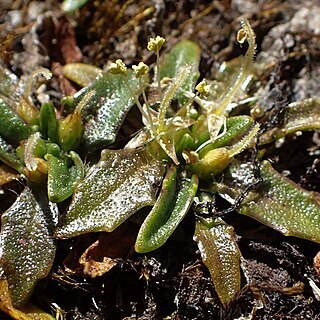Primary root short-lived. Stem short and broadly napiform, us. simple, with cop. long hairs. Rosette us. flat, 1-10 cm. diam.; lvs of firm texture, punctate, often black-blotched; lamina linear to broad-lanceolate, us. gradually (more abruptly in some coastal plants) narrowed into flat petiole; tip obtuse, margin entire in seedling, us. but not always becoming toothed to strongly pinnate-dentate in flowering stage; lf-hairs few or ∞, best developed on raised transverse ridges opp. bases of teeth, undersurface glab. Infls mostly hidden by long stem-hairs, each spike reduced to a single floret; scape extremely short at flowering, up to 2.5 cm. long at fruiting, almost glab. except for tuft of hairs immediately below bract. Bract and sepals < 1 mm. long, always much < basal portion of capsule, membr. and without keel, glab. Corolla-tube long (up to 2.5 mm.), lobes often only 3, erect, narrow, us. < 1·5 mm. long; stamens 3 or 4 (in same plant); anthers to 1 mm. long; ovules ∞; capsule to 3 mm. long, seeds 10-50, irregularly angular.

